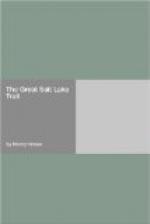This Indian whom I killed proved to be Tall Bull, one of the most able chiefs the Sioux ever had; and his death so affected the Indians that they at once retreated without further attempt to dislodge us.
Some days after this occurrence General Carr’s command was brought together again, and had an engagement with the Sioux, in which more than three hundred warriors and a large number of ponies were captured, together with several hundred squaws, among the latter being Tall Bull’s widow, who told with pathetic interest how the Prairie Chief[66] had killed her husband.
CHAPTER XVII. MASSACRE OF CUSTER’S COMMAND.
I remained at Fort Sedgwick during the winter, and early the following spring I returned to Fort McPherson, under orders to report to Major-General Emory of the Fifth Cavalry, who had been appointed commander of the District of the Republican, with headquarters at that post. As the command had been almost continuously in the field, it was generally thought that we were to have a long rest. During the fall of 1869 there were two or three scouting expeditions sent out, but nothing of very great importance was accomplished by them. There was plenty of game in the vicinity, and within a day’s ride there were large herds of deer, antelope, and elk, which I spent a great deal of time in hunting.
Early one morning in the spring of 1870 the Indians, who had approached the post during the night, stole twenty-one head of horses from a government contractor. They also ran off some of the government animals, and among the number my pony, Powder Face. Company I of the Fifth Cavalry was immediately ordered out after the savages, and I was directed to accompany them as trailer. We discovered their tracks after some difficulty, as the Indians were constantly trying to hide them, and we followed them sixty miles, when darkness set in.
We were within about four miles of Red Willow Creek, and I felt confident the Indians would camp that night in the vicinity. Advising the commanding officer to halt his company and “lay low,” I proceeded on to the creek, where, moving around cautiously, I suddenly discovered horses feeding in a bend of the stream on the opposite side. I hurried back to the troops with the information, and Lieutenant Thomas moved his company to the bank of the creek, with the intention of remaining there until daylight, and then, if possible, surprise the Indians.




